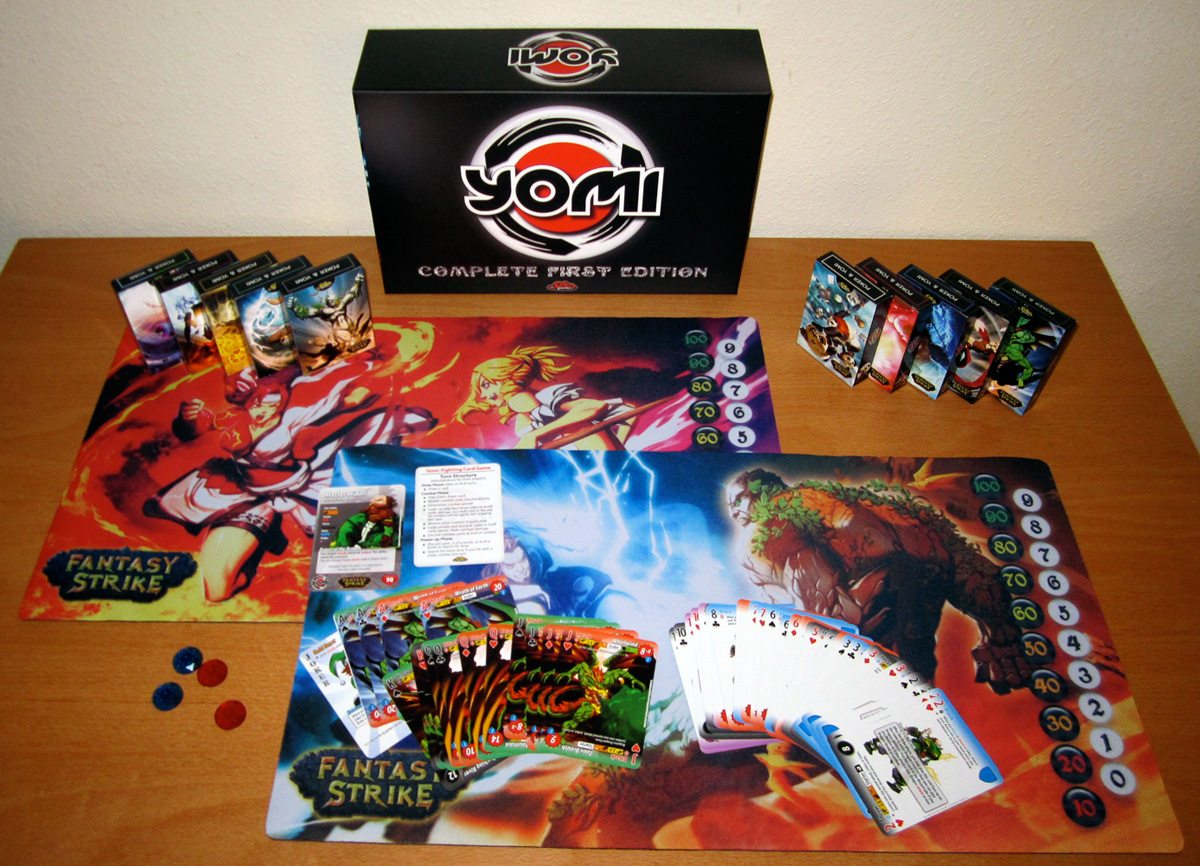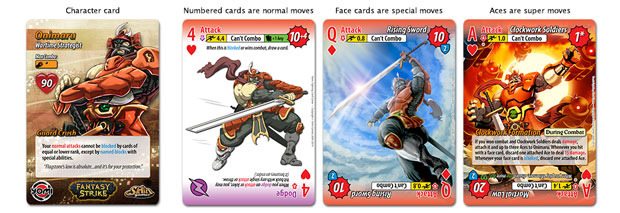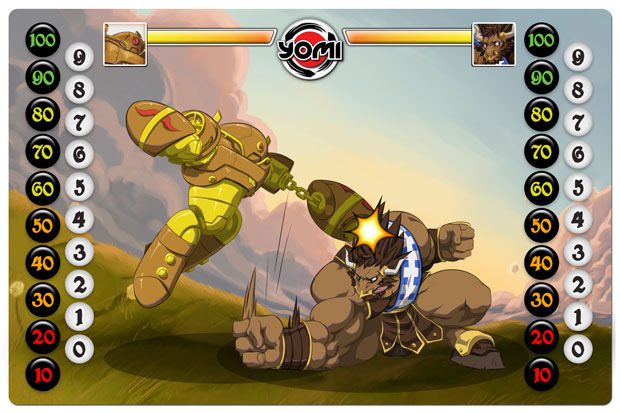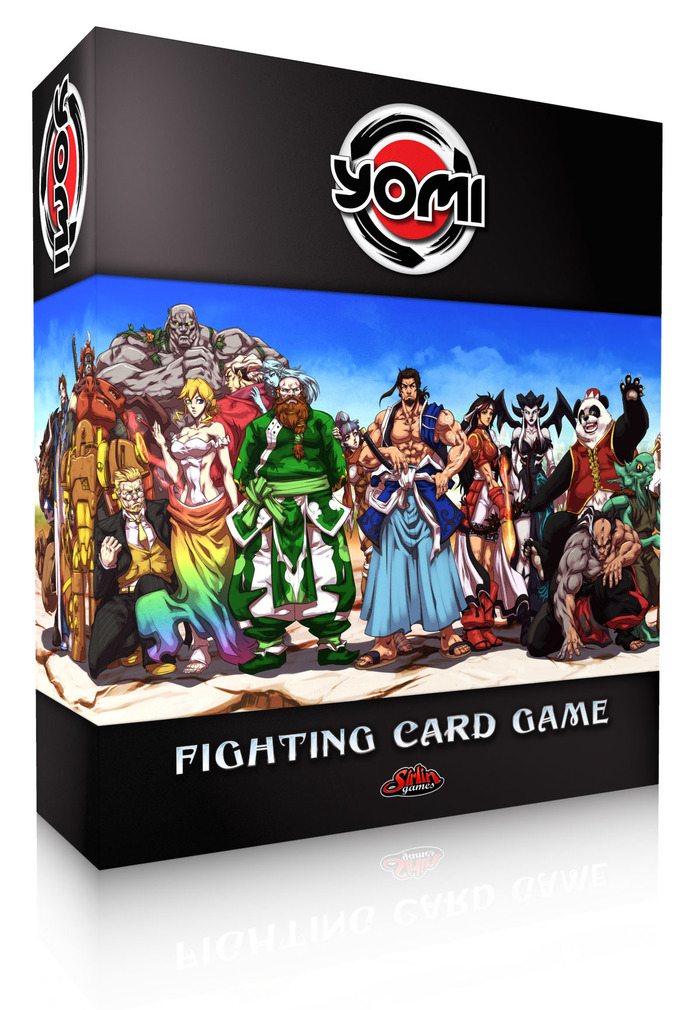Set in the Fantasy Strike universe, Yomi is a card-based fighting game inspired by fighting videogames like Street Fighter. The core mechanic is based on rock-paper-scissors, but builds a lot of strategy and depth on top of that foundation. David Sirlin’s ongoing Kickstarter campaign brings new characters, new play modes, and some revisions to the original base game.
New to Kickstarter? Read our Crowdfunding Basics post for a primer on how it works.
At a glance: Yomi is for 1 to 4 players, ages 10 and up, and takes about 30 minutes to play (though expect a little longer the first time you use a character). There are a host of different “packages” but basically it comes to about $10 per character, with 10 characters in the base set and 10 characters in the expansion, though you can get subsets of them. There’s also an EX Powerup add-on for $40, but more about that later. There are also a print-and-play version, an iPad app, and free online play, so there are plenty of cheaper ways to try out the game before you commit.

Components:
Again, since there are various versions and packages available, it’s hard to list all of the components. However, each character comes with a deck of cards: a 52-card poker deck plus two Jokers, a character card, and a turn summary card. The new versions will also include a stats card for each character, showing all of that character’s moves and abilities.
On the Kickstarter, you can get packages of 4 or 10 characters from “Round 1” (base set) or “Round 2” (expansion), though I should note that the expansion is stand-alone and can be played without the base set. If you already own the base game, the new version has been tweaked and revised—some abilities have been changed slightly, artwork has been improved, and card layout has also been redone to make things easier to understand. It’s possible to get just the revised cards for all of Round 1 rather than paying for a full new set, for about $10, though that’s bundled in with other purchases.

The EX Powerup Expansion is an additional $40 set that comes with EX versions of each character—ridiculously overpowered versions of the character cards, plus 4 Destiny cards (a new card rank) that add new special abilities. It also comes with an oversized Deathstrike Dragon card, which is used for the 2-vs-1 mode. Finally, the EX Powerup Expansion box will hold all twenty character decks.
There will also be boards and tokens to track your life points, though I’m not sure if the final version will be like the giant mousepad versions from the first edition or cardboard.
How to Play:
You can read an overview of how the game works on Sirlin Games or download the rules as a PDF. Here’s a quick run-down.
The goal of the game is to reduce your opponent’s life to zero.
Each player picks a character and marks their starting hit points as shown on the character card. The character card is set aside as a reference: it has a little chart showing the character’s maximum combo allowance, plus their relative abilities for attack, throw, block, and dodge. Each character also has its own special ability, outlined on the card. To begin, you shuffle and draw 7 cards.
For each turn, each player selects a card to play and puts it face down. Then both cards are revealed simultaneously, and you see who wins the attack. The diagram above shows the central idea—it’s like rock-paper-scissors. Attacks beat Throws; Throws beat Blocks and Dodges; Blocks and Dodges beat Attacks. However, they have different payoffs.
If you successfully block an attack, you get to put the block card back in your hand and draw another card. If you successfully attack or throw, you get the opportunity to followup with a combo, doing even more damage. If you dodge an attack, you can strike back with a single attack or throw. Each deck also has two Jokers, which allow you to avoid combo damage or can be used to search your deck for Aces, the most powerful attacks.
When both players play blocks or dodges, nothing happens. But if both play attacks or throws, then the faster move wins—each move has a speed printed on it, and the slower move gets discarded. Typically weaker moves are faster than stronger ones, but there are some notable exceptions, particularly with face cards and Aces, which tend to be both strong and fast. Once you’ve hit somebody (with an attack or throw) you can chain together more combos (up to your limit), but they have to be in numerical order or include “Linkers” that link together two attacks. Some cards are “Enders” that automatically end a combo.

Face cards and Aces are super-moves, generally with very high amounts of damage. Some will do a small amount of damage even if the opponent blocks, and some will allow you to discard additional cards for even more damage. For some characters, the Ace moves require a few more Aces in order to even play the move, so you have to store them up for a while.
There’s a power-up phase that lets you discard cards to pull Aces into your hand, plus you may also get Aces for hitting with certain types of combos.
Then, to start the next turn, each player draws one card and the game continues.
The game ends when one player’s life reaches zero.

A couple things to note: many of the cards are double-sided, so you can choose between two different moves depending on which way you rotate the card. Each character has its own strengths and weaknesses, so although the core mechanic remains the same, you’ll discover that the various characters play differently.
The new set of rules (which you can use even with just the original base set) includes additional modes. Triple Threat Mode is still for two players, but each person has three characters. Tag Team Mode allows four players to play against each other in teams, with rules for tagging in and out and assisting your teammate during combat. Dramatic Battle is a 2-vs-1 mode where the single player has a lot more health, a bigger hand size, and more card draws. Finally, there’s a solo mode with an AI—it won’t help you “read” your opponent, but it does help you develop familiarity with the values of attacks and types of abilities of the various character decks.
The Verdict
Yomi requires a bit of reading to get started: although the rules do fit on one instruction sheet, there’s a lot to take in and you may not get all the interactions right the first time through. The best way to learn, however, is to get started … which requires more reading as you study the various cards in your hand. Once you get going, most of the cards can be skimmed pretty quickly, and you’ll just need to take some more time to read face cards, Jokers, and the occasional cards with special abilities.
However, once you get used to a character’s abilities, you can move through a game pretty quickly, playing combos and resolving combat phases quickly. I found that the “best of three” play was particularly good at letting you get used to both your own character and your opponent’s. Or, you can play twice, trading characters for the second round.
One interesting aspect of the game is that, although you start with 7 cards in your hand, you will only draw one card per round. There is no “draw back up to 7” phase anywhere. So if you throw an attack combo that uses five cards, or you sacrifice a 3-of-a-kind to get some Aces, you’re not going to be left with as many cards to choose from. Successfully blocking is one way to get more cards back in your hand, but it’s also easy to waste a block (or get thrown) if your opponent is expecting this.
What’s really impressive about the game is how the characters can be so different yet still remain balanced. This is due in no small part to David Sirlin’s work in developing the game. Sirlin also did the balancing for Super Street Fighter II Turbo Remix (among other things), making sure that no single character was overpowered compared to the others. To pull this off without making all the characters clones of each other must be a pretty big challenge, but so far in my plays of Yomi it feels like it works.
And, like a video game, just because you take a few hits early on doesn’t mean that you can’t come back to win. I’ve played many games where one player gets a huge lead early on, but then succumbs. The name of the game comes from the Japanese word for “reading,” and it refers to being able to “read” your opponent’s mind. While the luck of the draw does matter, your ability to predict your opponent is even more crucial to victory.

I’ve gotten to try a couple of the new characters from Round 2, and it’s fun to see the different abilities and the way they interact. Onimaru has no combos, but his normal attacks can be very difficult to block, and many of his attacks can be “powered up” by discarding additional cards. Troq has the ability to switch into beast mode with a massive 45-point throw … but that only works against Blocks and Dodges, so you need to find the best time to play it. Quince has the ability to turn his rotate his face-cards after cards are revealed, which can be very powerful. And Bal-Bas-Beta, the clockwork soldier, can knock the other player back and perform long-range attacks.
The biggest barrier to playing Yomi, really, is the cost. For many people, the idea of spending $100 on ten decks of cards is out of the question, because they’re used to getting lots of cardboard and miniatures for that sort of money, and Yomi consists almost entirely of cards. The real value in Yomi comes in the gameplay and replayability—so you have to be the sort of player who enjoys playing the same game repeatedly in order to get deep into the strategy. I’ll admit: because I play so many different games, I really haven’t played Yomi enough in the past three years to really learn any of the characters in-depth. However, when I got it back out so I could try out the new Round 2 characters, I remembered what it was I liked about the game the first time around.
I think Yomi is excellent, with good balance and a lot of action. The artwork and production values (even though it’s mostly cards) is very high, and for players who will appreciate the strategic depth it’s worth it. I was always pretty lousy at fighting videogames, but Yomi gives me a chance to play without relying on fast thumbs. (I am, however, finding that I’m pretty bad at predicting other players, so clearly I need more training.)
It’s hard to say which set to recommend: completionists will certainly want the new base + expansion + EX Powerup set, which will set you back $240, but I imagine that’s going to be mostly people who have some experience with the game already and are sure they want the whole shebang. If you’re curious and want to dip your toe in before spending the big bucks, Yomi Round 1 or Round 2 are each $40 and come with 4 characters, which is enough to keep you busy for a while.
For more about Yomi and to pledge for a copy, check out the Yomi Kickstarter page, or visit the Sirlin Games website.
Disclosure: GeekDad received a review copy of this game.






